In my opinion most of the “sets” for barbecue knives are lackluster – and in most cases you’ll find that you don’t even use half the knives they provide you with.
Rather, I’d suggest building your own set.
If you are quite literally just starting out, I’d even opt to buy cheaper knives like Kiwi or KOM KOM. Just to get a feel for what you like without wasting tons of money.

While I’m not married to any of the brands I’m about to mention, they’re affordable, made from quality materials, and will likely last you a lifetime.
1. A Chef Knife – 8″ or 10″
If there’s one knife that I reach for most, it’s my Chef knife.

A Chef knife is essentially your all-purpose, everyday carry with regards to barbecue knives.
I use a Victorinox 8″ Fibrox Chef knife.
A good chef knife can be used to:
- Open any and all vacuum packaging material used for meat.
- Cut, trim, slice, segment, or carve meat at all stages (from raw to cooked – clean in between these stages).
- You can mince herbs or dice ingredients for a marinade, crush garlic with the flat end, etc.
A good chef knife is essentially your daily driver and could very well accomplish all the tasks of any of the specialized knives listed below – especially if you’re skilled enough.
2. A Slicing or Carving Knife
A knife that I know I will pretty much use without fail is a slicing knife – specifically, I use a Dexter-Russell 12″ Scalloped Slicer.

Whether you’re carving a turkey, slicing between pork rib bones, slicing brisket, or slicing a holiday ham – a slicer will create clean lines and improve your presentation.
Some people will even use these types of knives for trimming something like brisket.
I think it’s worth noting that most Barbecue restaurants will use this same Dexter Russell slicing knife.
When/if you go to order at a barbecue restaurant and they’re slicing meats and weighing them out in front of you, pay attention to the knife they’re using, there’s a very good chance it’s a Dexter Russell.
This list that Kevin curated from some of the top BBQ joints helps elicit this fact.
It should also be noted that while this slicer looks like a “bread knife” it is not – granted it could be used as one.
The Dexter Russell has a “scalloped” edge, where-as a traditional bread knife has a true “serrated” edge.

A serrated edge is designed to have sharp, aggressive teeth that make cutting into something like the crust of bread easy.
Similarly, it’s also not a traditional slicing knife with a straight edge. Straight edge slicers are better suited for creating thin slices – like you’d see for carving a turkey.
Scalloped slicers work well for cuts of meat that are fibrous – like for slicing brisket.
I know LOTs of people prefer straight-edge slicers, even for the tasks I listed above however if you watch enough of their videos you’ll notice when they go to “slice” they’re actually using a “see-sawing” motion that ruins their slices because it smoshes the meat.
Say you have a thicker bark on brisket or ribs, they won’t be able to cleanly slice with the straight edge – even tearing the bark in some cases. Rather, if they used a scalloped slicer they’d pull cleaner slices.
3. A Boning Knife
Boning knives are – as you might expect – used to separate meat from bones.
I use a 6″ boning knife by Mercer Culinary – it’s narrow, curved, and semi-stiff; Perfect for precise cutting close to bone, curved to filet a fish, and it even works well for trimming brisket.
Traditionally, a boning knife will have a prop tip point and a narrow, stiff blade.
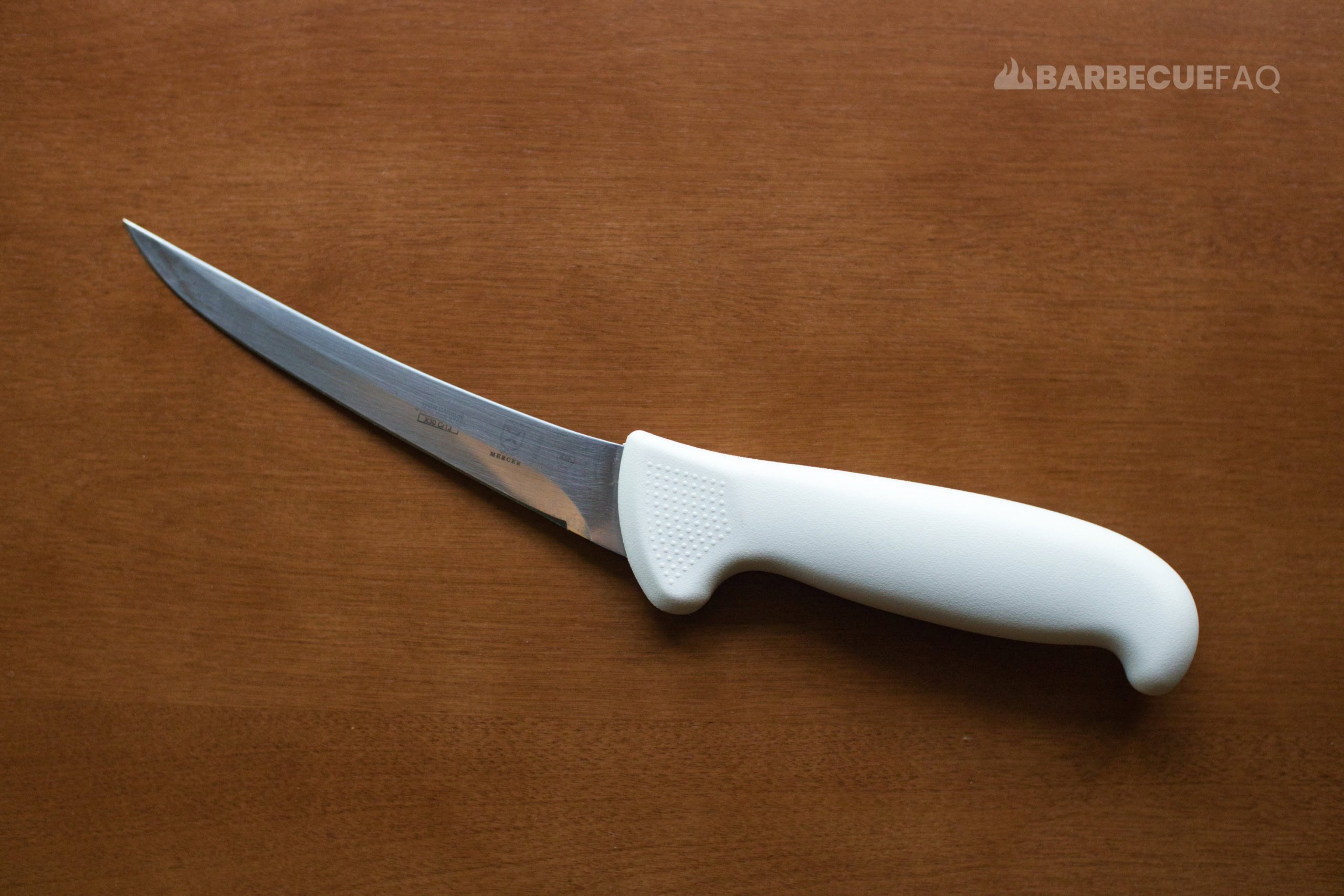
There are a few styles though:
- Narrow or Wide
- Flexible or Stiff
- Curved
All of these boning knives have specific use cases and again, it really boils down to your personal preference.
Wide blades are used for cutting into hearty cuts of meat where-as a narrow blade is better suited for precision cutting through and around bone and cartilage.
Curved edges and/or flexible boning knives work really well for creating optimal angles for cutting close to bone, where-as a stiff blade might otherwise suffer.
Personally, I don’t break down whole cows, let alone whole sides of beef. If I did, I’d likely invest in a more flexible boning knife.
Of the times I’ve had to break down a primal like say a whole sirloin, an 8″ breaking knife (below) and my 6″ boning knife make quick work of hard fat, gristle, silverskin, and separating musculature.
4. A Breaking Knife
If you’re someone who likes to cut their own meat, a breaking knife is quite useful.
I use an 8″ Victorinox Fibrox breaking knife.

Breaking knives are just as they sound too – they are designed to “break” through skin, small bones, fat, and cartilage.
This knife has qualities that make is especially useful for butchers.
Similar to a boning knife it’s flexible with a curved tip – this allows it to pass through large pieces of meat with ease. All the while being able to contort the knife and maneuver it through muscles and bones.
If you’re someone who is buying and only working with retail cuts (steaks, roasts, chops, etc.) – I wouldn’t buy this style of knife.
However, if you’re working with either whole primals or sub-primal cuts of beef, an 8″ breaking knife is more than enough. For instance, if you’re buying an entire strip loin to cut into NY Strip Steaks.
If you’re someone who is butchering a whole cow or a side of beef, then a larger 10″ breaking knife might be more appropriate.
5. A Paring Knife
The intended use for a paring knife is for paring or peeling as well as coring things like fruit.
I use a 4″ Victorinox Fibrox paring knife.
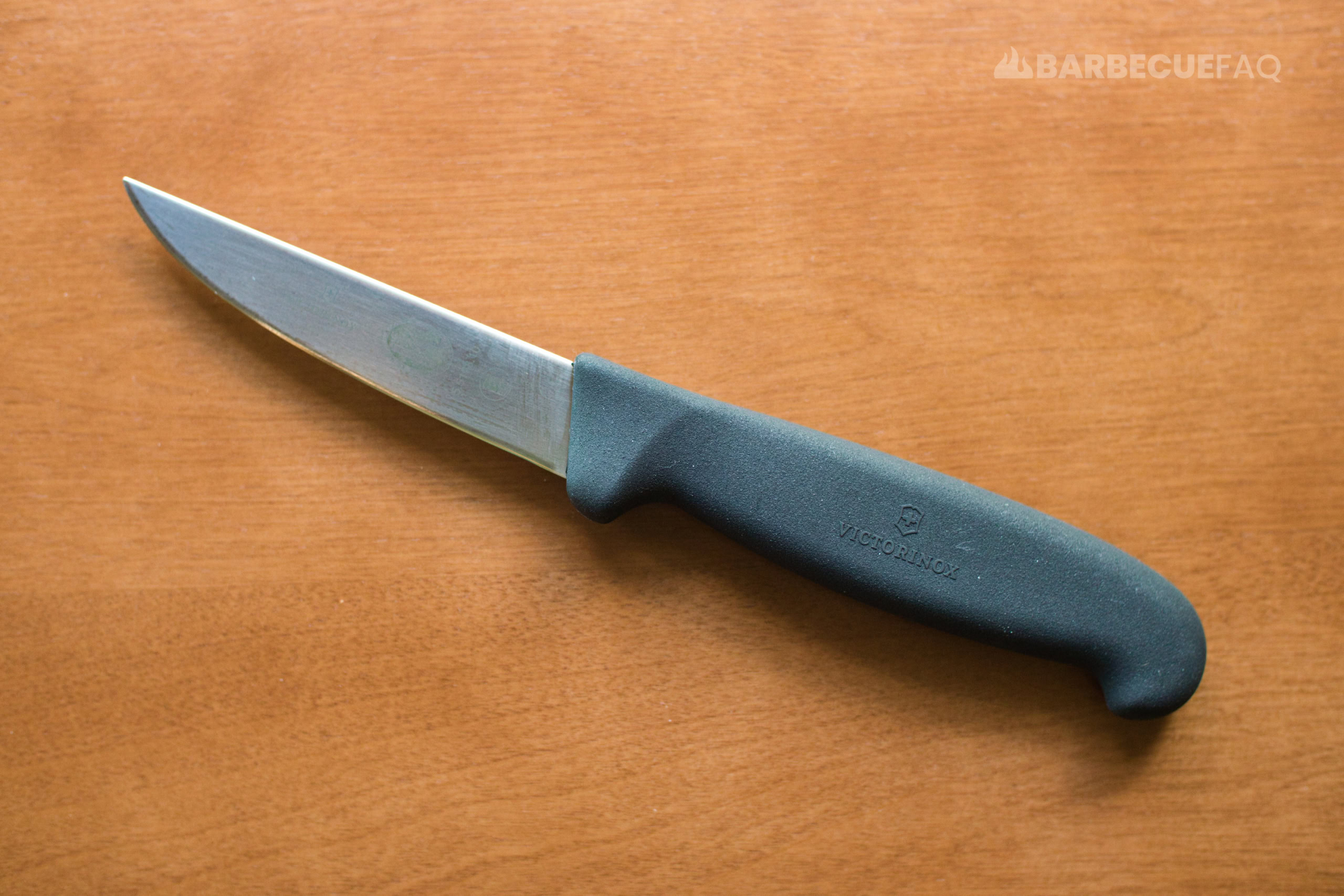
While some people might argue with me – i.e. some culinary professionals – I honestly find the paring knife to be my go-to after the chef knife.
Some other folks might prefer a smaller 6″ utility knife, but to each their own.
There’s several instances where an 8 or 10 inch Chef knife is just too much knife.
For me, paring knives are better suited for tasks that require precision and more controlled cutting.
Just to name examples off the top of my head as I’m writing this article:
- De-veining shrimp
- De-casing sausage or other cured meats
- Trimming chicken (a chef knife is far better for segmenting)
- Removing silverskin from various cuts of meat
- Scoring the skin side of a duck breast
Essentially, these are all tasks that you can perform with a regular Chefs knife but with a paring knife you’ll likely feel more in control.
6. A Pocket Knife?
While my pocket knife doesn’t interact with my cooked food, I definitely use it for a variety of barbecue related tasks.

To name a number of other tasks I’ve used my pocket knife for when barbecuing:
- Opening cryovac packaging
- Opening bottles of barbecue sauce or dry rub
- Cutting butcher paper from the roll
- Cutting cardboard/paper for firelighter for a charcoal chimney
You get the gist.
The humble pocket knife is an underappreciated instrument – even for barbecue.
If you are looking for a pocket knife, ensure you check your State requirements as everywhere you go is different – especially in terms of length and visibility.
For instance, in New York your pocket knife cannot exceed 4″ and must not be visible to the public view.
Where-as in New Hampshire (where I’m from) there is no limit on length.
While my current EDC pocket knife is my Grandfather’s, some of my favorite brands for pocket knives include:
- Opinel No.6 – 8 (I use #6)
- Spyderco KAPARA
- Kershaw Skyline
Any of the above would make great gifts and most won’t break the bank (especially the Opinel). If you’re looking for a “first” time pocket knife, go with Opinel No. 6, 7, or 8.

Dylan, Why So Many Victorinox Knives?
There’s tons of reasons:
- They’re actually affordable on a per knife basis where-as some Japanese knife brands will cost you $100-$300+ just for a chef knife.
- They come with a sharp edge and they hold their edge.
- Putting an edge back on them is also easy with honing steel.
- The Fibrox (TPE) handles are comfortable in the hand, they’re slip resistant, and easy to clean (even dishwasher safe).
- In terms of the blade – they’re stamped from a single sheet of metal (implying that it’s lighter since it’s not forged) and is made of Martensitic steel.
- Victorinox is a well respected company in the knife industry – from the same people who made the Original Swiss Army knife.
- Impressive warranty
I could likely keep going but I’m not big into gimmicks at all when it comes to barbecue. I just want tools that are affordable, reliable, and are long lasting and Victorinox Fibrox knives satisfy these requirements for me.
In terms of other Cutlery brands though, good examples to research are:
- Kiwi/KOM KOM (listed above)
- Zwilling
- Wusthof
- MAC
- Mercer (listed above)
- Dexter Russell (listed above)
Any of these brands I’d feel comfortable recommending to Family, Friends, and Readers.
While prices change often, the knives listed above (aside from a pocket knife) will likely run you ~$150-175 or ~$30-$35 a knife; Not bad considering the price of most knives.
Again though, always buy what YOU need to barbecue – what I need may be entirely different from what you need.


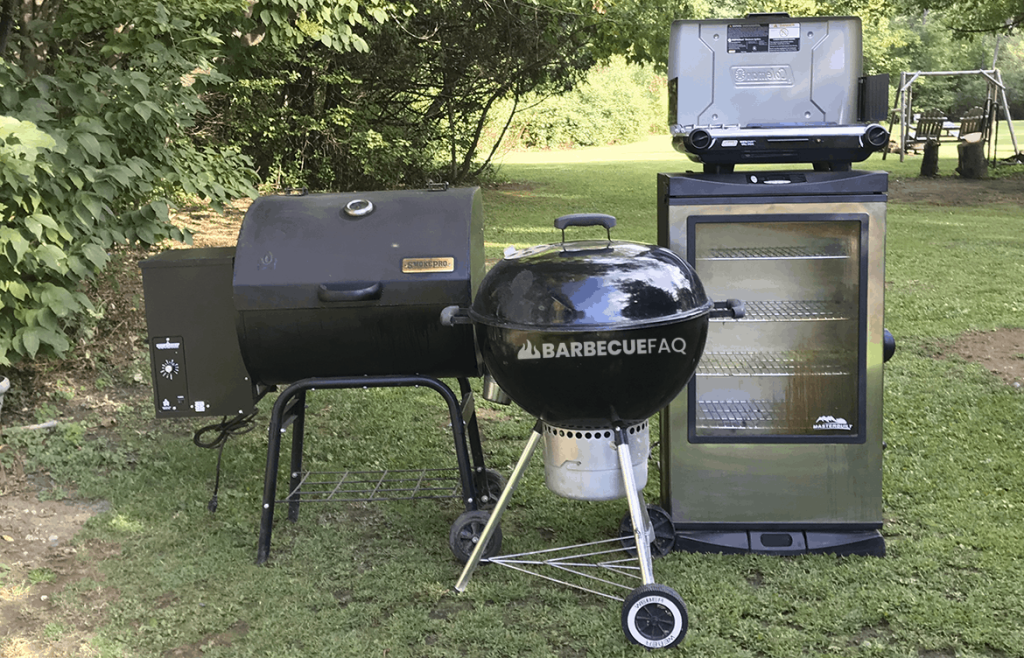
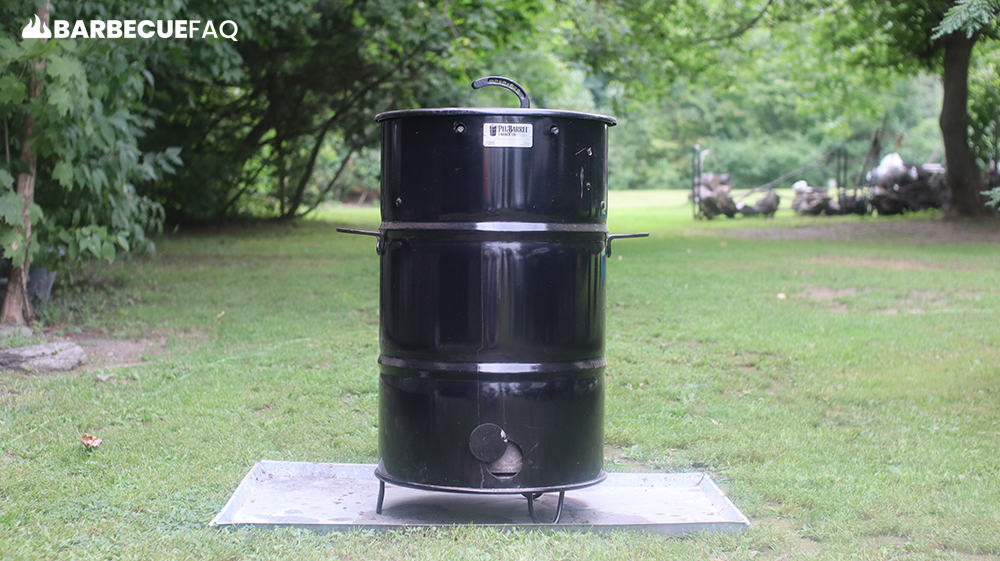
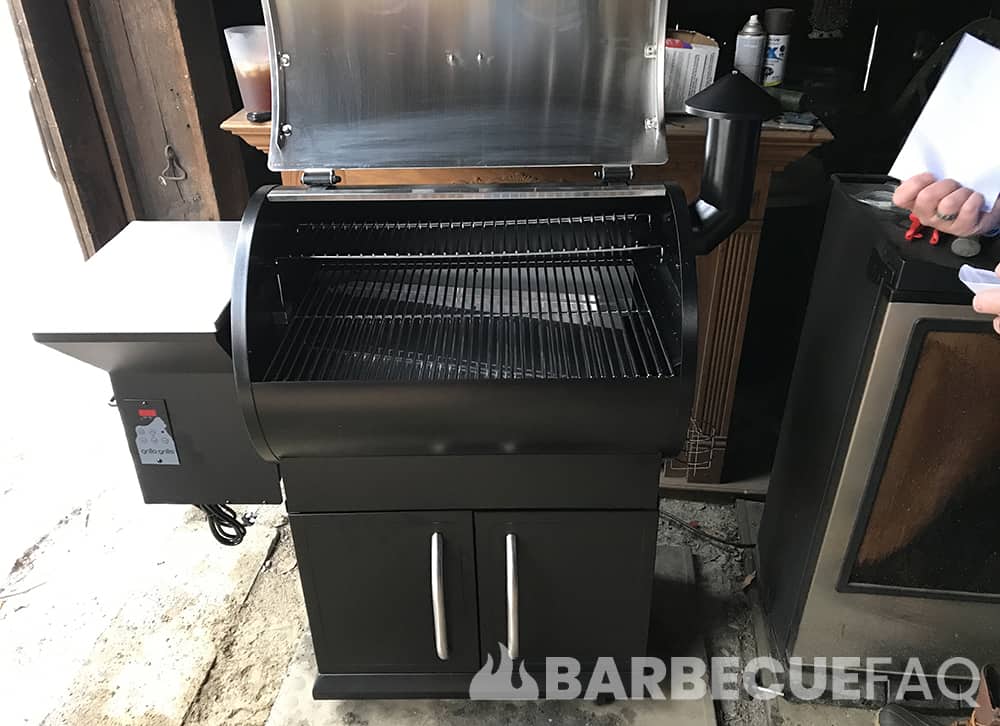
2 comments
Chris Jacobsen
Dylan,
Thank you for this. I have been, “Seriously” cooking, grilling, smoking and working with different proteins for a couple of years now, although the first time mI fired up and worked a grill was over 35 years ago.
I just came across your site and am grateful for everything I have seen so far. I do tons of research proteins, cuts, recipes, time, temp, equipment, flavor pairings, profiles, etc and to have a place where so much of this is in one spot is a real treat for me.
Thank you for sharing your passion, your experience and your expertise.
Dylan Clay
That means a lot Chris – truly.
Thanks for being a Reader and I’m happy to hear some folks find my verbosity worthy of reading.